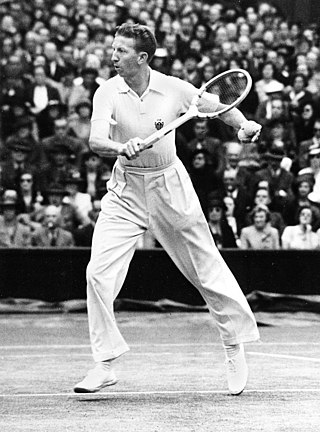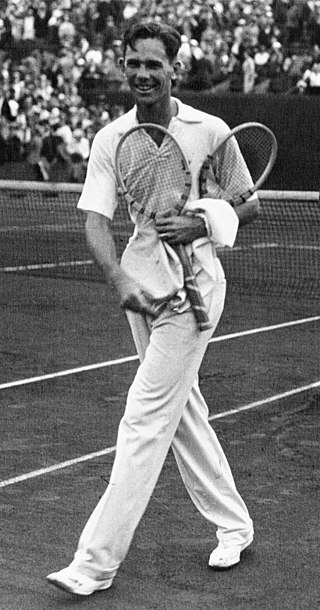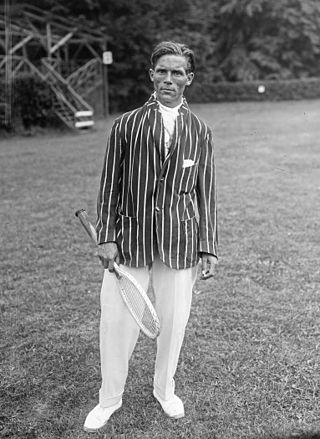
John Donald Budge was an American tennis player. He is most famous as the first tennis player — male or female, and still the only American male — to win the Grand Slam, and to win all four Grand Slam events consecutively overall. Budge was the second man to complete the career Grand Slam after Fred Perry, and remains the youngest to achieve the feat. He won ten majors, of which six were Grand Slam events and four Pro Slams, the latter achieved on three different surfaces. Budge is considered to have one of the best backhands in the history of tennis, with most observers rating it better than that of later player Ken Rosewall.

Frederick John Perry was a British tennis and table tennis player and former world No. 1 from England who won 10 Majors including eight Grand Slam tournaments and two Pro Slams single titles, as well as six Major doubles titles. Perry won three consecutive Wimbledon Championships from 1934 to 1936 and was World Amateur number one tennis player during those three years. Prior to Andy Murray in 2013, Perry was the last British player to win the men's Wimbledon championship, in 1936, and the last British player to win a men's singles Grand Slam title, until Andy Murray won the 2012 US Open.

Lewis Alan Hoad was an Australian tennis player whose career ran from 1950 to 1973. Hoad won four Major singles tournaments as an amateur. He was a member of the Australian team that won the Davis Cup four times between 1952 and 1956. Hoad turned professional in July 1957. He won the Kooyong Tournament of Champions in 1958 and the Forest Hills Tournament of Champions in 1959. He won the Ampol Open Trophy world series of tournaments in 1959, which included the Kooyong tournament that concluded in early January 1960. Hoad's men's singles tournament victories spanned from 1951 to 1971.

Kenneth Robert Rosewall is an Australian former world top-ranking professional tennis player. Rosewall won 147 singles titles, including a record 15 Pro Majors and 8 Grand Slam titles for a total 23 titles at pro and amateur majors. He also won 15 Pro Majors in doubles and 9 Grand Slam doubles titles. Rosewall achieved a Pro Slam in singles in 1963 by winning the three Pro Majors in one year and he completed the Career Grand Slam in doubles.

Ricardo Alonso "Pancho" González, known sometimes as Richard Gonzales, was an American tennis player. He won 15 major singles titles, including two U.S. National Singles Championships in 1948 and 1949, and 13 Professional Grand Slam titles. He also won three Tournament of Champions professional events in 1957, 1958, and 1959. He was ranked world amateur No. 1 in 1948 by Ned Potter and in 1949 by Potter and John Olliff.

Francisco Olegario Segura Cano, better known as Pancho "Segoo" Segura, was a leading tennis player of the 1940s and 1950s, both as an amateur and as a professional. He was born in Guayaquil, Ecuador, but moved to the United States in 1940. Throughout his amateur career he was listed by the USTA as a "foreign" player resident in the U.S. As a professional player, he was referred to as the "Ecuadorian champ who now lives in New York City". After acquiring U.S. citizenship in 1991 at the age of seventy, Segura was a citizen of both countries, although he never represented the U.S. in tennis competition.

Francis "Frank" Arthur Sedgman is an Australian former world No. 1 tennis player. Over the course of a three-decade career, Sedgman won five Grand Slam singles tournaments as an amateur as well as 22 Grand Slam doubles tournaments. He is one of only five tennis players all-time to win multiple career Grand Slams in two disciplines, alongside Margaret Court, Roy Emerson, Martina Navratilova and Serena Williams. In 1951, he and Ken McGregor won the Grand Slam in men's doubles. Sedgman turned professional in 1953, and won the Wembley World Professional Indoor singles title in 1953 and 1958. He also won the Sydney Masters tournament in 1958, and the Melbourne Professional singles title in 1959. He won the Grand Prix de Europe Professional Tour in 1959.

John Albert Kramer was an American tennis player of the 1940s and 1950s. He won three Grand Slam tournaments. He also led the U.S. Davis Cup tennis team to victory in the 1946 and 1947 Davis Cup finals.

Henry Ellsworth Vines Jr. was an American tennis champion of the 1930s, the World No. 1 player or the co-No. 1 in 1932 as an amateur, and in 1934, 1935, 1936 and 1937 as a professional. He won three Grand Slam titles, the U.S. National Championships in 1931 and 1932 and the Wimbledon Championships in 1932. Vines also was able to win Pro Slam titles on three different surfaces. He later became a professional golfer and reached the semifinals of the PGA Championship in 1951.

William Tatem Tilden II, nicknamed "Big Bill", was an American tennis player. Tilden was the world No. 1 amateur for six consecutive years, from 1920 to 1925, and was ranked as the world No. 1 professional by Ray Bowers in 1931 and 1932 and Ellsworth Vines in 1933. He won 14 Major singles titles, including 10 Grand Slam events, one World Hard Court Championships and three professional majors. He was the first American man to win Wimbledon, taking the title in 1920. He also won a joint-record seven U.S. Championships titles.
Hans "Hanne" Nüsslein was a German tennis player and coach and former World professional number 1 tennis player who won four professional Majors singles titles during his career.

Karel Koželuh was a Czech tennis, association football, and ice hockey player of the 1920s and 1930s. Koželuh became a European ice hockey champion in 1925 and was one of the top-ranked players on the professional tennis circuit in the 1930s.
Frank Kovacs was an American amateur and professional tennis player in the mid-20th century. He won the U.S. National Indoor Tennis Championships singles title in 1941. He won the World Professional Championships tournament in 1945 in San Francisco. Kovacs was successful on clay and won the Great Lakes Professional Clay Court Championships near Chicago in 1946, defeating Riggs in the final, and five U.S. Professional Clay Court Championships from 1948 to 1953. Kovacs won U.S. Professional Championships or International Professional Championships at Cleveland in 1951. He also won the U.S. Professional Challenge Tour in 1947 against Bobby Riggs.
World number 1 ranked male tennis players is a year-by-year listing of the male tennis players who were ranked as world No. 1 by various contemporary and modern sources. The annual source rankings from which the No. 1 players are drawn are cited for each player's name, with a summary of the most important tennis events of each year also included. If world rankings are not available, recent rankings by tennis writers for historical years are accessed, with the dates of the recent rankings identified. In the period 1948–1953, when contemporary professional world rankings were not created, the U.S. professional rankings are cited.
The U.S. Pro Tennis Championships was the oldest professional tennis tournament played until its final year of 1999 and is considered to have been a professional major from 1927–1967 until the advent of Open Era. In 1953, 1955, 1956, and 1960, the Cleveland World Pro had a women's draw, with Pauline Betz winning the first three of these, and defeating the reigning U.S. women's champion Doris Hart in the 1956 final. Althea Gibson defeated Pauline Betz in the 1960 women's final.
Since 1990, the biggest events in men's tennis have been the four Grand Slam tournaments, the ATP Finals and the ATP Masters tournaments, in addition to the Grand Slam Cup between 1990–99. From 1983 to 1990, men's tennis had a very strong tradition and clear hierarchy of tournaments: the Grand Slam tournaments, including Wimbledon, the US Open, the French Open, and the Australian Open; the season-ending Masters Grand Prix; and the Davis Cup. Before 1983, however, and in particular before the start of the Open Era in 1968, the hierarchy of professional tournaments changed virtually every year. For example, in 1934, the U.S. Pro was a high-class tournament with all the best players, but just two years later, the same tournament was ordinary because only professional teachers entered the event.
The Wembley Championships was a men's professional tennis tournament held from 1934–1990 with some periods of inactivity in between and is often considered to be one of the three Major professional tennis tournaments before the Open Era from 1927–1967 until the advent of the open era. Ken Rosewall's and Rod Laver's six singles titles are the record for this event. The tournament only had a men's draw.
The Tournament of Champions was a prominent professional tennis tournament series held at the West Side Tennis Club in Forest Hills, N.Y. and at Kooyong Stadium, Melbourne and White City Stadium, Sydney in Australia in 1957, 1958, and 1959.
For many years before the Open Era of tennis in 1968, the usual format for the handful of touring tennis professionals was a series of two-man one-night stands across the United States and often in other countries as well. The most notable of these tours were the "World Series" or "World Professional Championships", in which the reigning world champion went head-to-head against a challenger, most often the leading amateur of the previous year who had just turned pro. Promoters would attempt to sign the leading amateur to a contract with a minimum guarantee against a percentage of gate receipts, making a similar type of deal with the reigning professional champion and sometimes giving smaller percentages to undercard players. The winners of the tours were described as being the "world champion".
This article presents top ten lists of male singles tennis players, as ranked by various official and non-official ranking authorities throughout the history of the sport. Rankings of U.S.-only professionals pre-Open Era, and U.S.-only amateurs during World War II are also included.










